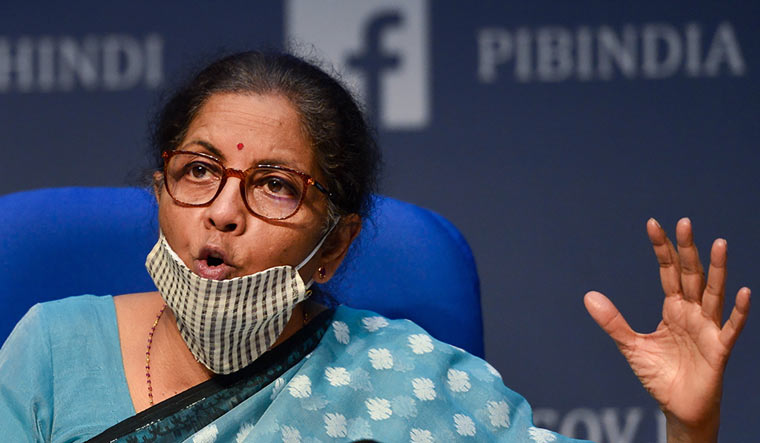As India moves towards lockdown 4.0 with a clear focus on resuscitating the economy, Finance Minister Nirmala Sitharaman announced the first tranche of relief measures with a cumulative value of Rs 6 lakh crore, a day after Prime Minister Narendra Modi revealed India's economic response to COVID-19 would total Rs 20 lakh crore.
The first tranche is a 'getting back to work' measure, as it provides enabling mechanisms for workers to get back gainful employment and for employers and businesses—especially Micro, Small and Medium Enterprises—to get back to production. The aim of the first intervention was clear: Introduce liquidity into the system so that small businesses which are the backbone of the country's economy can restart and pay their workers’ salaries.
In all, Sitharaman along with her deputy Anurag Thakur, the Minister of State for Finance, announced 16 measures. However, the finance minister left many questions unanswered as the full scale of the package is yet to be announced.
Former Finance Minister P. Chidambaram, who addressed a press conference immediately after Sitharaman's announcement, said there was nothing for the poor migrant workers who have been forced to walk hundreds of kilometres to reach their homes.
What many were hoping for was cash transfers to the poor—who have been hit the most due to the lockdown. BJP-ruled states like Madhya Pradesh and Uttar Pradesh had announced cash handouts of Rs 1,000 for each of the migrants returning to the state. Whether the Finance Minister will announce a similar cash handout will be known in the next few days.
The Modi government is under pressure to address the needs of the poor. While the government’s first package on March 27 ostensibly offered benefits to both farmers and the poor, it left out those who did not have access to ration cards or Jan Dhan Yojana accounts.
With a fortnight to go for Modi 2.0 government's first anniversary, the government will try to address the needs of several sections of the society, particularly the marginalised, which powered him to victory.
Since the government is pushing not just for relief but also for reforms, the definition of what constitutes an MSME was also revised—a move likely to help the sector grow. The key measures announced included a Rs 3 lakh crore emergency working capital facility for businesses, including MSMEs. This will come in the form of a term loan at a concessional rate of interest where the Government of India will stand guarantee. Since the government will only have to spend if the businesses do not repay their loans, this means that the government will not have to spend anything immediately by way of expenditure.
Economists say that many of the measures in the Rs 20 lakh crore package were already budgeted, similar to how parts of the first package announced on March 27—like advance payments for farmers—that had been budgeted.
For the stressed MSME units, Rs 20,000 crore of subordinated debt has been announced. For those units which need a bit of handholding, Rs 50,000 crore of equity infusion has been provisioned. For this purpose, a ‘Fund of Funds’ with a corpus of Rs 10,000 crore will be set up to provide equity funding support for MSMEs. “The Fund of Funds shall be operated through a mother and a few daughter funds. It is expected that with leverage of 1:4 at the level of daughter funds, the Fund of Funds will be able to mobilise equity of about Rs 50,000 crore,” the government statement said.
As government's emphasis is pushing local businesses to become self-reliant, the government said no global bidders would be invited for government tenders of up to Rs 200 crores.
Another key feature of today's measures was to put more money into employees’ hands. Sitharaman said the scheme introduced as part of Pradhan Mantri Garib Kalyan Yojana under which Government of India contributes 12 per cent of salary each on behalf of both employer and employee to EPF will be extended by another three months for salary months of June, July and August 2020. Total benefits accrued is about Rs 2,500 crores to 72.22 lakh employees. The employees will get to keep more money in hand as they contribute 10 per cent from the existing 12 per cent as PF contribution.
To address liquidity of NBFCs, the government will launch a Rs 30,000 crore Special Liquidity Scheme, with liquidity being provided by RBI
Another key measure is the Rs 90,000 crore 'liquidity injection' for discoms. The Power Finance Corporation and Rural Electrification Corporation will infuse liquidity in the DISCOMS to the extent of Rs 90,000 crore in two equal instalments. “This amount will be used by DISCOMS to pay their dues to transmission and generation companies. Further, CPSE GENCOs will give a rebate to discoms on the condition that the same is passed on to the final consumers as a relief towards their fixed charges,” Sitharaman said.
For the real estate sector, the registration and completion date for all registered projects will be extended up to 6 months and maybe further extended by another 3 months based on the state’s situation.
Other measures included certain tax-related measures where ‘Tax Deduction at Source and ‘Tax Collected at Source” for all non-salaried payment to residents, and tax collected at source rate will be reduced by 25 per cent of the specified rates for the remaining period of FY 20-21. This will provide liquidity to the tune of Rs 50,000 crore.



